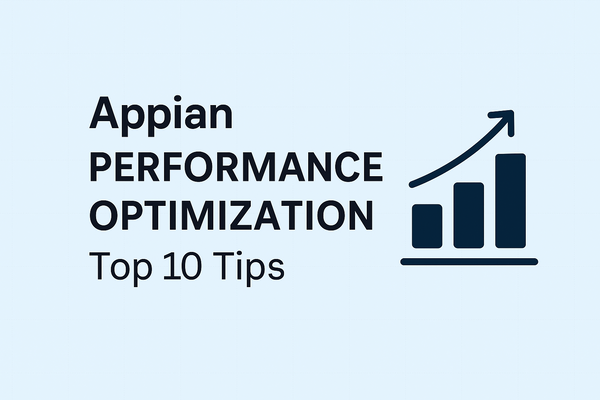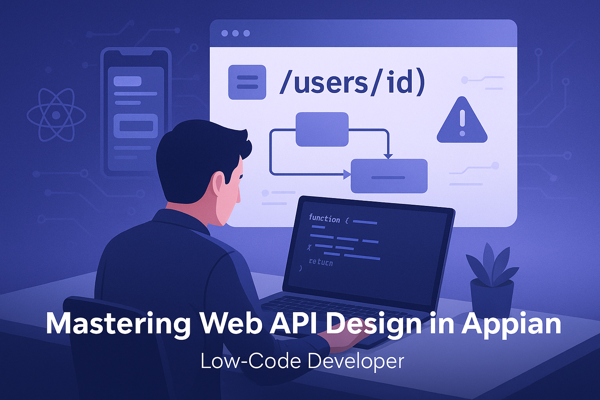
Performance Optimization in Appian: Top 10 Proven Tips That Actually Work
Slow UIs? Long-running processes? High memory usage? Here's a practical, field-tested guide to speed up your Appian applications with 10 optimization techniques that actually work.
🚀 1. Avoid Nested Expression Rules in Grids
Using too many nested expression rules in grids leads to repeated evaluations and slow rendering — especially with large datasets.
✅ Fix: Flatten your logic using a!localVariables() and avoid chaining heavy expressions inside each grid row.
a!localVariables(
local!data: rule!getGridData(),
...
)🧠 2. Query Only What You Need in Record Types
Avoid fetching entire record objects when you only need a few fields.
✅ Fix:
- Use the
fieldsparameter ina!queryRecordType() - Use proper
pagingInfoto avoid large unpaginated datasets - Don’t filter huge result sets in Appian – filter at source!
a!queryRecordType(
recordType: cons!EMPLOYEE_RECORD,
fields: {"id", "firstName", "department"},
pagingInfo: a!pagingInfo(startIndex: 1, batchSize: 20)
)🔁 3. Use Refresh Behavior Smartly in Interfaces
Misusing refreshAlways: true can reload components unnecessarily, leading to laggy UIs.
✅ Fix:
- Use
refreshOnReferenceChangeinstead - Refresh only when absolutely needed
- Avoid unnecessary dependencies between variables
⚙️ 4. Optimize Process Models for Performance
Bloated process models often cause memory spikes and slow executions.
✅ Fix:
- Break large models into smaller subprocesses
- Avoid storing large CDT arrays in PVs
- Don’t use parallel gateways where sequential flow suffices
- Monitor individual node execution times
🧠 Pro Tip: Use “Performance Monitoring” to identify long-running nodes or memory-heavy executions.
📊 5. Use Interface Performance Analyzer (IPA)
The most underused yet powerful performance tool in Appian.
✅ Fix:
- Access from Interface Designer → Tools → Performance Analyzer
- Identify expensive queries, heavy grids, and inefficient expressions
- Aim to keep render time under 1000ms
🧑⚕️ 6. Monitor Application Health with Logs & Alerts
Performance optimization is not one-time — it’s continuous monitoring.
✅ Fix:
- Enable Performance Monitoring in Admin Console
- Regularly check performance logs for slow APIs, PMs, and UIs
- Use Appian Health Check for periodic review
- Create alert rules when node/process time exceeds thresholds
🔔 Set up internal alerts for long-running processes (1+ min)
💾 7. Avoid Large Memory Consumption in Interfaces
Fetching too much data or showing all at once = high memory usage + poor UX.
✅ Fix:
- Always use pagination in grids
- Avoid
a!forEachon large datasets - Don’t load complex charts or images by default
🧪 Tip: Keep visible row count below 50 for smoother UI.
🧱 8. Optimize Your DB Queries and Views
Your app is only as fast as your DB.
✅ Fix:
- Avoid large joins without indexed columns
- Pre-aggregate in DB views when possible
- Keep
SELECT *queries out of Appian logic - Limit result set size with
LIMITor proper filters
📥 9. Use Caching Where Appropriate
Repeatedly fetching static data (config, dropdowns) slows things down.
✅ Fix:
- Use
a!refreshVariable(refreshInterval: 5)to cache values - Load dropdown lists once into a local variable
- Store config in constants or cached expressions
🌐 10. Optimize Web APIs & Integrations
Calling APIs during interface load can cause major lag.
✅ Fix:
- Fetch data after user interaction (e.g., button click)
- Use async APIs when backend supports it
- Reduce response payloads with field filtering
- Avoid nested integrations inside loops
✅ Conclusion
Performance issues are rarely caused by one thing — it’s a collection of small inefficiencies. By proactively using tools like IPA, monitoring logs, optimizing your DB, and designing smarter UIs/processes, you can make your Appian applications lightning-fast.
Let’s build smart. Let’s build together.


